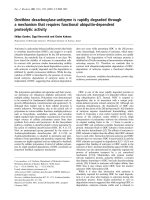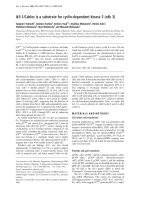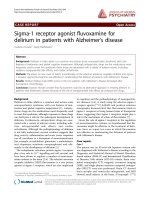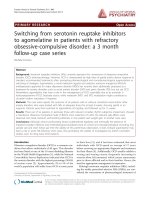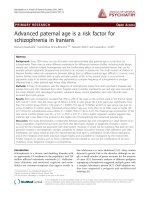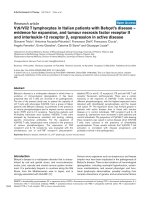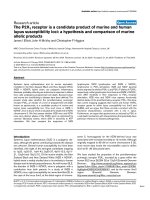Báo cáo y học: "Atherogenic lipid profile is a feature characteristic of patients with early rheumatoid arthritis: effect of early treatment – a prospective, controlled study" pps
Bạn đang xem bản rút gọn của tài liệu. Xem và tải ngay bản đầy đủ của tài liệu tại đây (360.96 KB, 7 trang )
Open Access
Available online />Page 1 of 7
(page number not for citation purposes)
Vol 8 No 3
Research article
Atherogenic lipid profile is a feature characteristic of patients with
early rheumatoid arthritis: effect of early treatment – a
prospective, controlled study
Athanasios N Georgiadis
1
, Eleni C Papavasiliou
2
, Evangelia S Lourida
2
, Yannis Alamanos
3
,
Christina Kostara
4
, Alexandros D Tselepis
2
and Alexandros A Drosos
1
1
Department of Internal Medicine, Medical School, University of Ioannina, 45110 Greece
2
Department of Chemistry, Laboratory of Biochemistry, University of Ioannina, 45110 Greece
3
Department of Hygiene and Epidemiology, Medical School, University of Ioannina, 45110 Greece
4
Laboratory of Biochemistry, University Hospital of Ioannina, 45500 Greece
Corresponding author: Alexandros A Drosos,
Received: 21 Dec 2005 Revisions requested: 19 Jan 2006 Revisions received: 10 Mar 2006 Accepted: 5 Apr 2006 Published: 28 Apr 2006
Arthritis Research & Therapy 2006, 8:R82 (doi:10.1186/ar1952)
This article is online at: />© 2006 Georgiadis et al.; licensee BioMed Central Ltd.
This is an open access article distributed under the terms of the Creative Commons Attribution License ( />),
which permits unrestricted use, distribution, and reproduction in any medium, provided the original work is properly cited.
Abstract
We investigated lipid profiles and lipoprotein modification after
immuno-intervention in patients with early rheumatoid arthritis
(ERA). Fifty-eight patients with ERA who met the American
College of Rheumatology (ACR) criteria were included in the
study. These patients had disease durations of less than one
year and had not had prior treatment for it. Smokers or patients
suffering from diabetes mellitus, hypothyroidism, liver or kidney
disease, Cushing's syndrome, obesity, familiar dyslipidemia and
those receiving medications affecting lipid metabolism were
excluded from the study. Sixty-three healthy volunteers
(controls) were also included. Patients were treated with
methotrexate and prednisone. Lipid profiles, disease activity for
the 28 joint indices score (DAS-28) as well as ACR 50%
response criteria were determined for all patients. The mean
DAS-28 at disease onset was 5.8 ± 0.9. After a year of therapy,
53 (91.3%) patients achieved the ACR 20% response criteria,
while 45 (77.6%) attained the ACR 50% criteria. In addition, a
significant decrease in the DAS-28, C-reactive protein (CRP)
and erythrocyte sedimentation rate (ESR) were observed. ERA
patients exhibited higher serum levels of total cholesterol (TC),
low-density lipoprotein cholesterol (LDL-C) and triglycerides,
whereas their serum high-density lipoprotein cholesterol (HDL-
C) levels were significantly lower compared to controls. As a
consequence, the atherogenic ratio of TC/HDL-C as well as that
of LDL-C/HDL-C was significantly higher in ERA patients
compared to controls. After treatment, a significant reduction of
the atherogenic ratio of TC/HDL-C as well as that of LDL-C/
HDL-C was observed, a phenomenon primarily due to the
increase of serum HDL-C levels. These changes were inversely
correlated with laboratory changes, especially CRP and ESR. In
conclusion, ERA patients are characterized by an atherogenic
lipid profile, which improves after therapy. Thus, early immuno-
intervention to control disease activity may reduce the risk of the
atherosclerotic process and cardiovascular events in ERA
patients.
Introduction
Rheumatoid arthritis (RA) is a chronic systemic disease affect-
ing primarily the synovium, leading to joint damage and bone
destruction [1]. RA causes significant morbidity as a result of
synovial inflammation, joint destruction and associated disabil-
ity [2]. Epidemiological studies have shown an increased pre-
mature mortality in patients with RA compared with the general
population [3-7]. Several investigators reported an excess of
cardiovascular morbidity and mortality among RA patients. In
active RA, the majority of cardiovascular deaths result from
accelerated atherosclerosis [2,8,9]. Risk factors for athero-
sclerotic events and cardiovascular disease include male sex,
increased age, elevated plasma total cholesterol (TC) and low-
density lipoprotein cholesterol (LDL-C), decreased high-den-
ACR = American College of Rheumatology; ApoA-I = apolipoprotein A-I; ApoB = apolipoprotein B; CAD = coronary artery disease; CETP = choles-
terol ester transfer protein; CRP = C-reactive protein; DAS-28 = disease activity for 28 joint indices score; DMARDs = disease modifying antirheu-
matic drugs; ERA = early rheumatoid arthritis; ESR = erythrocyte sedimentation rate; HDL-C = high density lipoprotein cholesterol; LDL-C = low-
density lipoprotein cholesterol; MTX = methotrexate; RA = rheumatoid arthritis; TC = total cholesterol.
Arthritis Research & Therapy Vol 8 No 3 Georgiadis et al.
Page 2 of 7
(page number not for citation purposes)
sity lipoprotein cholesterol (HDL-C), high blood pressure,
smoking and diabetes mellitus [10-13]. Approximately 50% of
atherosclerotic coronary artery disease (CAD) in the commu-
nity occurs in the absence of traditional risk factors [14].
In general, and with some variations between different studies,
the lipid profile of patients with active or untreated RA is pri-
marily characterized by a decrease in serum levels of HDL-C
whereas contrasting results have been published on the
serum levels of TC and LDL-C [15-20]. Importantly, the reduc-
tion in HDL-C has as a consequence the increase in the TC/
HDL-C ratio [15]. This ratio represents an atherogenic index,
which is an important prognostic marker for cardiovascular
disease [15]. Indeed, the risk of myocardial infarction
increases considerably when this ratio is higher than five, and
it should ideally be four or less [15,16]. The serum TC and
HDL-C levels in RA are inversely correlated with disease activ-
ity [15], suggesting a potential role for inflammation in the
atherogenic profile and the higher atherosclerotic risk
observed in RA [17].
The cholesterol ester transfer protein (CETP) has a central role
in HDL metabolism and in the regulation of HDL-C levels in
serum. CETP exchanges cholesterol esters with triglycerides
between HDL and apolipoprotein B-containing lipoproteins
and thus significantly contributes to the reverse cholesterol
transport pathway. High levels of CETP activity lead to a
reduction in HDL-C levels and an atherogenic lipoprotein pro-
file [21,22]. Thus, mutations in the CETP gene associated with
CETP deficiency are characterized by high serum HDL-C lev-
els and reduced cardiovascular risk [23].
Our knowledge about the effect of treatment on the lipid pro-
file of patients with RA is limited and only cross-sectional and
short term uncontrolled studies have been performed [15,17-
20]. In addition, studies on lipid profile and CETP activity, as
well as studies on the effect of therapy on these parameters in
early RA (ERA) patients, are scarce. On the other hand,
atherosclerosis is a chronic process and only long-term
changes of the lipid profile might affect cardiovascular dis-
ease. Therefore, we undertook a prospective, controlled study
to investigate the lipid profile and CETP activity in ERA
patients as well as the long-term effects of immuno-interven-
tion on these parameters in patients with active disease.
Materials and methods
Patients
Inclusion criteria
Fifty-eight consecutive, unselected patients who were referred
to the outpatient rheumatology clinic between January 2004
and September 2005 were investigated. All patients fulfilled
the American College of Rheumatology (ACR) 1987 criteria
for RA [24], had early disease with disease duration of less
than one year without prior use of disease modifying antirheu-
matic drugs (DMARDs) and or systemic steroids.
Exclusion criteria
Smokers or patients suffering from conditions that affect the
lipid profile, such as diabetes mellitus, hypothyroidism, liver or
kidney disease, Cushing's syndrome, obesity (body mass
index >30) and a history of familial dyslipidemia, were
excluded. In addition, patients receiving medications affecting
lipid metabolism, such as lipid-lowering drugs, beta-blockers,
oral contraceptives, estrogen, progestin, thyroxin and vitamin
E, were excluded from the study.
Sixty-three apparently healthy, non-smoking volunteers also
participated in the study and were used as a control group.
These subjects were selected from blood donors during the
last two months of the patients' selection period and fulfilled
the same exclusion criteria reported for the patient group.
None of the subjects participating in the control group had a
history of CAD. The control group was proportionally matched
for age and sex to the patient group. All controls reported no
significant changes in their body weight for at least three
months before entry to the study. All patients and controls
gave informed consent and the study protocol was approved
by the Institutional Ethics Committee.
Study design
Patients were treated with methotrexate (MTX; 0.2 mg/kg/
week; mean ± standard deviation 15.5 ± 1.3) and prednisone
(7.5 mg/day). The dose of MTX remained stable during the
study while the dose of prednisone was tapered according to
a patient's clinical response. Disease activity was assessed by
measuring the disease activity for 28 joint indices score (DAS-
28) [25], while the clinical response was evaluated according
to the ACR 50% response criteria [26]. All patients were fol-
lowed up every month for the first three months, and every
three months thereafter. During the follow up period, a ques-
tionnaire concerning changes in dietary habits was carefully
fulfilled by all patients. The body weight was also measured
appropriately in each visit.
Blood sampling and laboratory monitoring
Overnight fasting blood samples were obtained at baseline
and after 12 months follow-up from both ERA patients and the
control group. Serum lipids were determined within six hours
of blood sampling. TC, triglycerides and HDL-C were deter-
mined on an Olympus AU560 Clinical Chemistry analyser
(Hamburg, Germany) as previously described [27]. LDL-C
was estimated using the Friedewald formula [28]. Non-HDL-C
levels were estimated by subtracting HDL-C from TC. Serum
apolipoproteins B and A-I (apoB and apoA-I, respectively)
were measured by immunonephelometry with the aid of a
Behring Nephelometer BN100 and reagents (antibodies and
calibrators) from Behring Diagnostics GmbH (Liederbach,
Germany). C-reactive protein (CRP) and IgM rheumatoid fac-
tor were measured by nephelometry. Erythrocyte sedimenta-
tion rate (ESR) was measured by the modified Westergren
method. In addition, complete blood count with differential, as
Available online />Page 3 of 7
(page number not for citation purposes)
well as serum glucose, liver and kidney function tests and uri-
nalysis, were performed at each patient visit until the end of the
study. CETP activity was measured by a fluorometric assay,
using a commercially available kit (Roar Biomedical, Inc., New
York, NY, USA). Briefly, 2 µl of plasma diluted 1:1 with sample
buffer (10 mmol/l Tris, 150 mmol/l NaCl, and 2 mmol/l EDTA,
pH 7.4) were used as the source of CETP. The assay was per-
formed for 1 hour at 37°C and the CETP activity was deter-
mined by the increase in fluorescence intensity measured in a
fluorescence spectrometer at an excitation wavelength of 465
nm and emission wavelength of 535 nm [29].
Statistical analysis
All data were analyzed with the STATISTICA 5.1 program.
Comparisons between groups were conducted using the t
test. Correlation between variables was examined using the
Pearson's correlation coefficient. A p value < 0.05 was consid-
ered statistically significant.
Results
During the selection period (January 2004 to September
2005), a total of 72 patients were recruited. Of these, 14 were
excluded; 7 who were current smokers, 2 with diabetes melli-
tus, 4 who had hypertension treated with propranolol and diu-
retics and 1 who had hypothyroidism. Thus, 58 patients were
included in the study. None of the patients reported a modifi-
cation of dietary habits or experienced significant changes in
body weight during the study. The clinical characteristics and
lipid profiles of patients before and after therapy and normoli-
pidemic controls are described in Table 1. There were 44
women and 14 men with a mean age of 53.6 ± 15.3 years and
mean disease duration of 0.8 ± 0.3 years. Fifty-three (91.3%)
of the patients achieved the ACR 20% response criteria, while
45 (77.6%) attained the ACR 50% criteria. Forty-three
(74.13%) patients had a good response, while 11 (18.96%)
had a moderate response, according to the European League
Against Rheumatism criteria [30]. The mean dose of pred-
nisone after one year of treatment was 4.6 ± 1.8 mg/day. No
significant side effects were noted during the study, the drugs
being well tolerated, while two patients were lost to follow-up.
ERA patients exhibited mild but significant higher baseline
serum levels of TC, LDL-C, nonHDL-C, triglycerides and apoB
(Table 1). Importantly, the serum HDL-C and apoA-I levels
were significantly lower compared to controls. As a conse-
quence, the atherogenic ratio of TC/HDL-C as well as that of
LDL-C/HDL-C was significantly higher in ERA patients com-
pared to controls.
Table 1
Clinical characteristics and lipid profile of patients with early rheumatoid arthritis and controls
Controls (N = 63) Patients
Baseline (N = 58) Post treatment (N = 56)
Sex (male/female) 20/43 14/44 13/43
Age (years) 58.4 ± 17.7 53.6 ± 15.3 54.7 ± 14.8
Body mass index (kg/m
2
) 25.8 ± 17.7 25.5 ± 3.3 25.8 ± 3.1
IgM rheumatoid factor (+/-) 0/0 45/13 44/13
C-reactive protein (mg/dl) 2.1 ± 1.3 28.15 ± 20.75 4.60 ± 4.20
a
ESR (mm/h) 5.2 ± 3.1 48.0 ± 19.7 14.6 ± 8.7
a
DAS-28 - 5.8 ± 0.9 2.7 ± 1.0
a
TC (mg/dl) 190.4 ± 33.9 216.5 ± 50.3
b
228.1 ± 42.1
c
LDL-C (mg/dl) 126.5 ± 31.3 141.6 ± 42.3
b
140.4 ± 32.4
HDL-C (mg/dl) 51.1 ± 7.4 47.5 ± 11.8
2
60.7 ± 13.4
a
NonHDL-C (mg/dl) 139.3 ± 30.2 172.0 ± 46.3
b
167.4 ± 37.4
Triglycerides (mg/dl) 97.1 ± 28.3 133.0 ± 58.2
b
131.5 ± 56.1
TC/HDL-C 3.7 ± 0.9 4.9 ± 1.3
b
3.8 ± 0.8
a
LDL-C/HDL-C 2.5 ± 0.8 3.0 ± 1.0
b
2.4 ± 0.6
a
Apolipoprotein B (mg/dl) 93 ± 19 103 ± 28
b
105 ± 30
Apolipoprotein A-I (mg/dl) 144 ± 23 127 ± 27
d
152 ± 22
a
Values represent the mean ± standard deviation.
a
p < 0.001 and
c
p < 0.05 compared to the baseline values;
b
p < 0.001 and
d
p < 0.01 compared
to the control group. DAS-28, disease activity for 28 joint indices score; ESR, erythrocyte sedimentation rate; LDL-C, low-density lipoprotein
cholesterol; HDL-C, high-density lipoprotein cholesterol; TC, total cholesterol.
Arthritis Research & Therapy Vol 8 No 3 Georgiadis et al.
Page 4 of 7
(page number not for citation purposes)
After 12 months of therapy, a significant decrease in the DAS-
28 and ESR values as well as in the CRP levels were observed
(Table 1). Furthermore, post treatment levels of HDL-C were
significantly higher compared to the baseline values. By con-
trast, the serum levels of LDL-C and nonHDL-C were not sig-
nificantly altered after treatment. Due to the significant
increase in HDL-C levels, the post treatment levels of TC were
significantly elevated (Table 1). Importantly, the atherogenic
ratios TC/HDL-C and LDL-C/HDL-C were significantly
reduced after treatment, a phenomenon primarily due to an
early treatment-induced increase in the serum levels of HDL-C
(Table 1). Finally, no changes in the post treatment serum lev-
els of triglycerides were noted.
It should be noted that the increase in TC and HDL-C serum
levels induced by early immuno-intervention was inversely cor-
related with the reduction in the serum CRP levels and ESR
values (Figure 1a,b and Figure 2a,b). Finally, no correlation
between the DAS-28 values and the above lipid parameters
were observed (data not shown).
The most important observation of the present study is the
increase of serum HDL-C levels induced by immuno-interven-
tion in ERA patients. In an effort to investigate the mechanism
for the HDL-C increase, we determined the CETP activity in
controls as well as in ERA patients before and after one year
of therapy. The baseline values of CETP activity in ERA
patients were significantly higher compared to controls,
whereas they were significantly reduced after one year of ther-
apy (Figure 3). It should be noted that no significant alterations
were observed in the CETP activity of controls after one year
of follow-up (19.0 ± 4.1).
Discussion
Our objective was to determine the lipid profile of ERA
patients and to investigate whether this could be influenced by
treating RA in the early stages of disease. According to our
results, patients with early active RA before therapy exhibited
an atherogenic lipid profile characterized by an increase of TC,
LDL-C, nonHDL-C and triglyceride serum levels and a reduc-
tion in serum HDL-C levels. Thus, an increase in the athero-
genic ratio of TC/HDL-C or LDL-C/HDL-C is observed in ERA
Figure 1
Correlation of total cholesterol (TC) and high-density lipoprotein cho-lesterol (HDL-C) with C-reactive protein (CRP)Correlation of total cholesterol (TC) and high-density lipoprotein cho-
lesterol (HDL-C) with C-reactive protein (CRP). Inverse correlation of
CRP differences with (a) TC and (b) HDL-C differences (r = -0.54, p <
0.0001 and r = -0.59, p < 0.0001, respectively).
Figure 2
Correlation of total cholesterol (TC) and high-density lipoprotein cho-lesterol (HDL-C) with erythrocyte sedimentation rate (ESR)Correlation of total cholesterol (TC) and high-density lipoprotein cho-
lesterol (HDL-C) with erythrocyte sedimentation rate (ESR). Inverse
correlation of ESR differences with (a) TC and (b) HDL-C differences
(r = -0.28, p < 0.04 and r = -0.30, p < 0.03, respectively).
Available online />Page 5 of 7
(page number not for citation purposes)
patients, suggesting that these patients are possibly exposed
to a higher risk of atherosclerosis.
The lipid profile of patients with RA has been evaluated in sev-
eral studies. Some of these studies have reported lower levels
of HDL-C and TC, higher serum concentrations of lipoprotein
(a) and higher TC/HDL-C and LDL-C/HDL-C ratios in active
and/or untreated disease than in the general population
[16,20,31,32]. However, other studies have not shown signif-
icantly different lipid levels from those observed in the healthy
population [33,34] and others refer to an overall reduction in
all lipid sub-fractions in cases of active disease [15,35,36].
These contrasting results could be attributed to the size of the
samples, the type of study (prospective or cross-sectional),
differences in the disease type (established or early), or to dif-
ferences in the disease activity. Patients in remission or with
controlled disease show an increase in HDL-C levels and a
reduction in the atherogenic index compared to patients with
active disease [15].
Systemic inflammation may also play a role in the development
of atherosclerosis [31,33]. In fact, the increase of acute phase
reactants in cardiovascular events has already been docu-
mented [31]. It has even been suggested that RA and athero-
sclerosis may share a common predisposition factor
[32,33,37]; CRP is the common denominator for both dis-
eases [38,39]. CRP, which increases in active disease, may
contribute to atherosclerosis because it stimulates macro-
phages to produce tissue factor, a procoagulant that is found
in atherosclerotic plaques. The presence of CRP in athero-
matic lesions also suggests a 'cause and effect' relationship
between this acute phase reactant and coronary events
[21,39].
An important observation of the present study is that ERA
patients exhibit low HDL-C serum levels, which are signifi-
cantly increased after immuno-intervention in parallel with the
reduction of CRP levels and ESR values. Importantly, the
increase in HDL-C levels was inversely correlated with the
reduction in either CRP levels or ESR values. This suggests
that inflammation is an important determinant for the reduced
HDL-C levels observed in ERA patients. By contrast, immuno-
intervention did not influence the serum levels of LDL-C and
triglycerides and it is thus unlikely that inflammation is respon-
sible for the elevation of these lipid parameters observed at
baseline in our patients.
In an effort to investigate the biochemical basis for the
reduced HDL-C levels exhibited by ERA patients at baseline,
we determined the serum levels of CETP activity. CETP
exchanges cholesterol esters with triglycerides between HDL
and apoB-containing lipoproteins, leading to the reduction in
HDL-C levels [21,22]. Increased CETP activity is associated
with low HDL-C levels as well as with an overall atherogenic
profile [21]. However, several studies have provided contrast-
ing results as to whether CETP itself represents an independ-
ent risk predictor for CAD. As HDL-C levels are inversely
related to CAD risk, it is hypothesized that inhibition of CETP
activity would lead to the reduction in the risk for CAD [40,41].
Based on this assumption, several inhibitors of CETP are cur-
rently under investigation in large scale clinical studies [23].
According to our results, ERA patients exhibited significantly
higher CETP activity at baseline compared to controls. Thus,
we may hypothesize that the reduced HDL-C levels, and con-
sequently the atherogenic lipid profile observed in our patients
before treatment, could be attributed at least partially to the
higher baseline levels of CETP activity. This hypothesis is fur-
Figure 3
Cholesterol ester transfer protein (CETP) activity of controls and early rheumatoid arthritis patients before and after therapyCholesterol ester transfer protein (CETP) activity of controls and early rheumatoid arthritis patients before and after therapy. Data are expressed as
means ± standard deviation. *p < 0.001 compared with controls;
#
p < 0.05 compared with pretreatment values.
Arthritis Research & Therapy Vol 8 No 3 Georgiadis et al.
Page 6 of 7
(page number not for citation purposes)
ther supported by the finding that immuno-intervention signifi-
cantly reduced CETP activity in parallel with the elevation of
the serum HDL-C levels. However, we cannot exclude the pos-
sibility that the increased CETP activity and the reduced HDL-
C levels observed in our patients at baseline could also be
attributed to the fact that several inflammatory mediators
inhibit cholesterol efflux from cells by reducing expression of
the ATP-binding cassette A1 gene [42]. This possibility is cur-
rently under investigation in our laboratory.
The use of DMARDs in ERA for controlling the disease activity
may reduce articular damage. Several DMARDs exist for treat-
ing RA, but low dose MTX is usually the main choice. Long-
term observational studies for periods up to 10 years have
shown a sustained clinical response and an acceptable toxic-
ity profile for MTX treatment [43-46]. In addition, patients with
severe RA who do not respond to MTX have a poor prognosis,
with increased mortality compared to the general population
[47], while RA patients who respond to MTX exhibit a substan-
tial survival benefit, mainly by reducing cardiovascular mortality
[43,48]. However, there is no clear evidence that the
DMARDs used to treat RA decrease the risk of atherosclero-
sis, or that they are directly protective [49].
Corticosteroids, on the other hand, have a potentially athero-
genic effect, given that they cause dyslipidemia and hyperten-
sion [15,16]. In spite of this, the effect of their long-term
administration in RA is not yet completely understood [15,16].
Several studies have been unable to demonstrate any associ-
ation between cardiovascular mortality and the use of corti-
costeroids [50]. A recent study reported a small or no increase
in TC levels during long-term administration of corticosteroids
[15]. The increase in the prevalence of diabetes mellitus in RA
as a late complication of the metabolic syndrome has not been
associated with corticosteroid use either [33]. Some authors
have extrapolated that the adverse effects of corticosteroids
can be counterbalanced, as they exert better control over the
inflammatory activity of the disease [51].
It is possible that RA patients may have some classic risk fac-
tors for atherosclerosis development. However, it is not cor-
rect to attribute the increased prevalence of atherosclerosis
observed in RA patients to these factors. In our study, we tried
to exclude patients with classic risk factors for atherosclerosis
and we found that ERA patients with high disease activity
showed an adverse lipid profile before the commencement of
therapy. After one year of treatment, a significant clinical and
laboratory improvement was noted. This was correlated with
changes in the lipid profile, mainly the increase of HDL-C.
HDLs are particles with numerous atheroprotective functions,
including facilitation of reverse cholesterol transport, improve-
ment of endothelial function, protection of LDL from oxidation,
limitation of hemostasis and retardation of inflammatory activity
related to the vascular wall [40]. Since our inclusion criteria
were very strict, it is obvious that some reservations should be
taken for the extrapolation and generalization of our results for
all RA patients.
Conclusion
These findings provide evidence that early immuno-interven-
tion with MTX and corticosteroids controlling the inflammatory
process may reduce the risk of atherosclerosis and
cardiovascular events in ERA patients. Further, long term lon-
gitudinal studies are needed to demonstrate if early treatment
in RA patients reduces the risk of cardiovascular events.
Competing interests
The authors declare that they have no competing interests.
Authors' contributions
ANG wrote the paper and participated in the collection of the
data. ECP and ESL performed the biochemical and lipoprotein
profile. YA carried out the statistics. CK performed the assays
for ApoA-I and ApoB. ADT performed the control of the statis-
tics and the lipoprotein profile. AAD conceived the study, par-
ticipated in its design and coordination and helped to draft the
manuscript. All authors read and approved the final
manuscript.
References
1. Gravallese EM: Bone destruction in arthritis. Ann Rheum Dis
2002, 61(Suppl 2):ii84-ii86.
2. Gabriel SE, Crowson CS, Kremers HM, Doran MF, Turesson C,
O'Fallen WM, Matteson EL: Survival in rheumatoid arthritis: a
population-based analysis of trends over 40 years. Arthritis
Rheum 2003, 48:54-58.
3. Isomaki HA, Mutru O, Koota K: Death rate and causes of death
in patients with rheumatoid arthritis. Scand J Rheumatol 1975,
4:205-208.
4. Mutru O, Laakso M, Isomaki H, Koota K: Ten year mortality and
causes of death in patients with rheumatoid arthritis. Br Med
J (Clin Res Ed) 1985, 290:1797-1799.
5. Watson DJ, Rhodes T, Guess HA: All-cause mortality and vas-
cular events among patients with rheumatoid arthritis, oste-
oarthritis, or no arthritis in the UK General Practice Research
Database. J Rheumatol 2003, 30:1196-1202.
6. Pinals RS: Survival in rheumatoid arthritis. Arthritis Rheum
1987, 30:473-475.
7. Mitchell DM, Spitz PW, Young DY, Bloch DA, McShane DJ, Fries
JF: Survival, prognosis, and causes of death in rheumatoid
arthritis. Arthritis Rheum 1986, 29:706-714.
8. Goodson N: Coronary artery disease and rheumatoid arthritis.
Curr Opin Rheumatol 2002, 14:115-120.
9. Van Doornum S, McColl G, Wicks IP: Accelerated atherosclero-
sis: an extraarticular feature of rheumatoid arthritis. Arthritis
Rheum 2002, 46:862-873.
10. Castelli WP, Garrison RJ, Wilson PW, Abbott RD, Kalousdian S,
Kannel WB: Incidence of coronary heart disease and lipopro-
tein cholesterol levels. The Framingham study. JAMA 1986,
256:2835-2838.
11. Kannel WB, Neaton JD, Wentworth D, Thomas HE, Stamler J, Hul-
ley SB, Kjelsberg MO: Overall and coronary heart disease mor-
tality rates in relation to major risk factors in 325,348 men
screened for the MRFIT. Multiple Risk Factor Intervention Trial.
Am Heart J 1986, 112:825-836.
12. Manninen V, Elo MO, Frick MH, Haapa K, Heinonen OP, Heinsalmi
P, Helo P, Huttunen JK, Kaitaniemi P, Koskinen P, et al.: Lipid
alterations and decline in the incidence of coronary heart dis-
ease in the Helsinki Heart Study. JAMA 1988, 260:641-651.
13. Cui Y, Blumenthal RS, Flaws JA, Whiteman MK, Langenberg P,
Bachorik PS, Bush TL: Non-high-density lipoprotein cholesterol
Available online />Page 7 of 7
(page number not for citation purposes)
level as a predictor of cardiovascular disease mortality. Arch
Intern Med 2001, 161:1413-1419.
14. Ross R: The pathogenesis of atherosclerosis: a perspective for
the 1990s. Nature 1993, 362:801-809.
15. Boers M, Nurmohamed MT, Doelman CJ, Lard LR, Verhoeven AC,
Voskuyl AE, Huizinga TW, van de Stadt RJ, Dijkmans BA, van der
Linden S: Influence of glucocorticoid and disease activity on
total and high density lipoprotein cholesterol in patients with
rheumatoid arthritis. Ann Rheum Dis 2003, 62:842-845.
16. Situnayake R, Kitas G: Dyslipidemia and rheumatoid arthritis.
Ann Rheum Dis 1997, 56:341-342.
17. Park YB, Lee SK, Lee WK, Suh CH, Lee CW, Lee CH, Song CH,
Lee J: Lipid profiles in untreated patients with rheumatoid
arthritis. J Rheumatol 1999, 26:1701-1704.
18. Lorber M, Aviram M, Linn S, Scharf Y, Brook JG: Hypocholester-
olaemia and abnormal high-density lipoprotein in rheumatoid
arthritis. Br J Rheumatol 1985, 24:250-255.
19. Frati E, Castagna ML, Bacarelli MR, Fioravanti A, Giordano N, Tad-
deo A, Marcolongo R: Plasma levels of apolipoprotein and HDL-
cholesterol in patients with rheumatoid arthritis. Boll Soc Ital
Biol Sper 1984, 60:1791-1796.
20. Lazarevic MB, Vitic J, Mladenovic V, Myones BL, Skosey JL,
Swedler WI: Dyslipoproteinemia in the course of active rheu-
matoid arthritis. Semin Arthritis Rheum 1992, 22:172-178.
21. Tall AR: Plasma cholesteryl ester transfer protein. J Lipid Res
1993, 34:1255-1274.
22. Barter PJ: Hugh Sinclair Lecture: the regulation and remodel-
ling of HDL by plasma factors. Atheroscler Suppl 2002,
3:39-47.
23. Forrester SJ, Makkar R, Shah PK: Increasing high-density lipo-
protein cholesterol in dyslipidemia by cholesteryl ester trans-
fer protein inhibition. An update for clinicians. Circulation
2005, 111:1847-1854.
24. Arnett FC, Edworthy SM, Bloch DA, McShane DJ, Fries JF, Cooper
NS, Healey LA, Kaplan SR, Liang MH, Luthra HS, et al.: The Amer-
ican Rheumatism Association 1987 revised criteria fort he
classification of rheumatoid arthritis. Arthritis Rheum 1988,
31:315-324.
25. Prevoo ML, van't Hof MA, Kuper HH, van Leeuwen MA, van de
Putte LB, van Riel PL: Modified disease activity scores that
include twenty-eight-joint counts. Development and validation
in a prospective longitudinal study of patients with rheumatoid
arthritis. Arthritis Rheum 1995, 38:44-48.
26. Felson DT, Anderson JJ, Boers M, Bombardier C, Furst D, Gold-
smith C, Katz LM, Lightfoot R Jr, Paulus H, Strand V, et al.: Amer-
ican College of Rheumatology. Preliminary definition of
improvement in rheumatoid arthritis. Arthritis Rheum 1995,
38:727-735.
27. Tsimihodimos V, Karabina SA, Tambaki AP, Bairaktari E, Miltiadous
G, Goudevenos JA, Cariolou MA, Chapman MJ, Tselepis AD, Elisaf
M: Altered distribution of PAF-acetylhydrolase activity
between LDL and HDL as a function of the severity of
hypercholesterolemia. J Lipid Res 2002, 43:256-263.
28. Friedewald WT, Levy RI, Fredrickson DS: Estimation of the con-
centration of low-density lipoprotein cholesterol in plasma,
without use of the preparative ultracentrifuge. Clin Chem
1972, 18:499-502.
29. Ordovas JM, Cupples LA, Corella D, Otvos JD, Osgood D, Mar-
tinez A, Lahoz C, Coltell O, Wilson PW, Schaefer EJ: Association
of cholesteryl ester transfer protein-TaqIB polymorphism with
variations in lipoprotein subclasses and coronary heart dis-
ease risk. The Framingham study. Arterioscler Thromb Vasc
Biol 2000, 20:1323-1329.
30. van Gestel AM, Anderson JJ, van Riel PL, Boers M, Haagsma CJ,
Rich B, Wells G, Lange ML, Felson DT: ACR and EULAR
improvement criteria have comparable validity in rheumatoid
arthritis trials. American College of Rheumatology European
League of Associations for Rheumatology. J Rheumatol 1999,
26:705-711.
31. Del Rincon ID, Williams K, Stern MP, Freeman GL, Escalante A:
High incidence of cardiovascular events in a rheumatoid
arthritis cohort not explained by traditional cardiac risk factors.
Arthritis Rheum 2001, 44:2737-2745.
32. Dessein PH, Stanwix AE, Moomal Z: Rheumatoid arthritis and
cardiovascular disease may share similar risk factors (Letter).
Rheumatology 2001, 40:703-704.
33. Dessein PH, Stanwix AE, Joffe BI: Cardiovascular risk in rheu-
matoid arthritis versus osteoarthritis: acute phase response
related decreased insulin sensitivity and high-density lipopro-
tein cholesterol as well as clustering of metabolic syndrome
features in rheumatoid arthritis. Arthritis Res 2002, 4:R5.
34. Hurt-Camejo E, Paredes S, Masana L, Camejo G, Sartipy P,
Rosengren B, Pedreno J, Vallve JC, Benito P, Wiklund O: Elevated
levels of small, low-density lipoprotein with high affinity for
arterial matrix components in patients with rheumatoid arthri-
tis: possible contribution of phospholipase A2 to this athero-
genic profile. Arthritis Rheum 2001, 44:2761-2767.
35. Munro R, Morrison E, McDonald AG, Hunter JA, Madhok R, Capell
HA: Effect of disease modifying agents on the lipid profiles of
patients with rheumatoid arthritis. Ann Rheum Dis 1997,
56:374-377.
36. Svenson KL, Lithell H, Hallgren R, Selinus I, Vessby B: Serum
lipoprotein in active rheumatoid arthritis and other chronic
inflammatory arthritides. I. Relativity to inflammatory activity.
Arch Intern Med 1987, 147:1912-1916.
37. Pasceri V, Yeh ET: A tale of two diseases: atherosclerosis and
rheumatoid arthritis. Circulation 1999, 100:2124-2126.
38. Wallberg-Jonsson S, Cvetkovic JT, Sundqvist KG, Lefvert AK, Ran-
tapaa-Dahlqvist S: Activation of the immune system and inflam-
matory activity in relation to markers of atherothrombotic
disease and atherosclerosis in rheumatoid arthritis. J
Rheumatol 2002, 29:875-882.
39. Jonsson SW, Backman C, Johnson O, Karp K, Lundstrom E, Sun-
dqvist KG: Increased prevalence of atherosclerosis in patients
with medium term rheumatoid arthritis. J Rheumatol 2001,
28:2597-2602.
40. Gotto AM Jr: Low high-density lipoprotein cholesterol as a risk
factor in coronary heart disease: a working group report. Cir-
culation 2001, 103:2213-2218.
41. de Grooth GJ, Smilde TJ, van Wissen S, Klerkx AH, Zwinderman
AH, Fruchart JC, Kastelein JJ, Stalenhoef AF, Kuivenhoven JA: The
relationship between cholesteryl ester transfer protein levels
and risk factor profile in patients with familial
hypercholesterolemia. Atherosclerosis 2004, 173:261-267.
42. Baranova I, Vishnyakova T, Bocharov A, Chen Z, Remaley AT,
Stonik J, Eggerman TL, Patterson AP: Lipopolysaccharide down
regulates both scavenger receptor B1 and ATP binding cas-
sette transporter A1 in RAW cells. Infect Immun 2002,
70:2995-3003.
43. Kremer JM, Phelps CT: Long-term prospective study of the use
of methotrexate in the treatment of rheumatoid arthritis.
Update after a mean of 90 months. Arthritis Rheum 1992,
35:138-145.
44. Papadopoulos NG, Alamanos Y, Papadopoulos IA, Tsifetaki N,
Voulgari PV, Drosos AA: Disease modifying antirheumatic
drugs in early rheumatoid arthritis: a longterm observational
study. J Rheumatol 2002, 29:261-266.
45. Sany J, Anaya JM, Lussiez V, Couret M, Combe B, Daures JP:
Treatment of rheumatoid arthritis with methotrexate: a pro-
spective open longterm study of 191 cases. J Rheumatol 1991,
18:1323-1327.
46. Weinblatt ME, Weissman BN, Holdsworth DE, Fraser PA, Maier
AL, Falchuk KR, Coblyn JS: Long-term prospective study of
methotrexate in the treatment of rheumatoid arthritis. 84-
month update. Arthritis Rheum 1992, 35:129-137.
47. Krause D, Schleusser B, Herborn G, Rau R: Response to meth-
otrexate treatment is associated with reduced mortality in
patients with severe rheumatoid arthritis. Arthritis Rheum
2000, 43:14-21.
48. Choi HK, Hernan MA, Seeger JD, Robins JM, Wolfe F: Methotrex-
ate and mortality in patients with rheumatoid arthritis: a pro-
spective study. Lancet 2002, 359:1173-1177.
49. Rewald E, de las Mercedes Francischetti M: Methotrexate treat-
ment and mortality in rheumatoid arthritis. Lancet 2002,
360:1097.
50. Wallberg-Jonsson S, Ohman ML, Dahlqvist SR: Cardiovascular
morbidity and mortality in patients with seropositive rheuma-
toid arthritis in Northern Sweden. J Rheumatol 1997,
24:445-451.
51. Park YB, Choi HK, Kim MY, Lee WK, Song J, Kim DK, Lee SK:
Effects of antirheumatic therapy on serum lipid levels in
patients with rheumatoid arthritis: a prospective study. Am J
Med 2002, 113:188-193.
